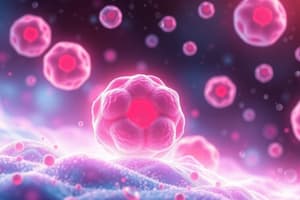Podcast
Questions and Answers
In the context of parasitic helminth infections, which of the following mechanisms BEST describes how eosinophil granules contribute to the expulsion or elimination of the parasite?
In the context of parasitic helminth infections, which of the following mechanisms BEST describes how eosinophil granules contribute to the expulsion or elimination of the parasite?
- Eosinophil granules induce rapid apoptosis of helminth cells via caspase activation, leading to parasite disintegration.
- Eosinophil granules stimulate the release of endogenous neurotransmitters from helminths, causing paralysis and expulsion.
- Eosinophil granules release cytotoxic mediators that disrupt the helminth's outer cell wall, facilitating its detachment and subsequent clearance. (correct)
- Eosinophil granules catalyze the formation of insoluble immune complexes on the helminth surface, preventing nutrient uptake and causing starvation.
Consider a scenario where a patient presents with elevated levels of both eosinophils and neutrophils. What are the possible etiologies?
Consider a scenario where a patient presents with elevated levels of both eosinophils and neutrophils. What are the possible etiologies?
- Genetic predisposition to myeloproliferative neoplasms with secondary IgE-mediated hypersensitivity.
- Chronic exposure to environmental toxins (e.g., asbestosis) complicated by opportunistic fungal infection.
- Concurrent parasitic infestation and bacterial superinfection. (correct)
- Acute viral infection coupled with latent autoimmune disorder reactivation.
Given the distinct roles of mast cells and basophils in type I hypersensitivity reactions, which intracellular signaling pathway is MOST likely activated downstream of IgE receptor crosslinking in both cell types?
Given the distinct roles of mast cells and basophils in type I hypersensitivity reactions, which intracellular signaling pathway is MOST likely activated downstream of IgE receptor crosslinking in both cell types?
- MAPK pathway, resulting in degranulation and synthesis of lipid mediators such as leukotrienes and prostaglandins. (correct)
- NF-κB pathway, inducing expression of adhesion molecules and chemokines for immune cell recruitment.
- PI3K-Akt-mTOR pathway, promoting cell survival and long-term cytokine production.
- JAK-STAT pathway, leading to transcriptional upregulation of pro-inflammatory cytokines.
If a patient undergoing treatment for a chronic helminth infection develops anaphylaxis shortly after the administration of an anti-helminthic drug, which mechanism is MOST likely responsible for the immediate hypersensitivity reaction?
If a patient undergoing treatment for a chronic helminth infection develops anaphylaxis shortly after the administration of an anti-helminthic drug, which mechanism is MOST likely responsible for the immediate hypersensitivity reaction?
A researcher is investigating the migration patterns of eosinophils during an allergic inflammatory response in lung tissue. Which chemokine receptor interaction is MOST likely to mediate the recruitment of eosinophils from the bloodstream into the inflamed lung parenchyma?
A researcher is investigating the migration patterns of eosinophils during an allergic inflammatory response in lung tissue. Which chemokine receptor interaction is MOST likely to mediate the recruitment of eosinophils from the bloodstream into the inflamed lung parenchyma?
A patient with a history of severe anaphylaxis following bee stings is prescribed an epinephrine auto-injector. Beyond its bronchodilatory effects, what is the MOST critical mechanism by which epinephrine counteracts anaphylaxis?
A patient with a history of severe anaphylaxis following bee stings is prescribed an epinephrine auto-injector. Beyond its bronchodilatory effects, what is the MOST critical mechanism by which epinephrine counteracts anaphylaxis?
Considering the heterogeneity of mast cell populations in different tissues, which of the following BEST explains the observed variations in their responses to IgE-mediated activation and subsequent mediator release?
Considering the heterogeneity of mast cell populations in different tissues, which of the following BEST explains the observed variations in their responses to IgE-mediated activation and subsequent mediator release?
During the sensitization phase of type I hypersensitivity, which cellular interaction is essential for the class switching of B cells to produce IgE antibodies specific to the allergen?
During the sensitization phase of type I hypersensitivity, which cellular interaction is essential for the class switching of B cells to produce IgE antibodies specific to the allergen?
In the context of developing novel therapeutics for allergic rhinitis, which strategy would be MOST effective in preventing the late-phase inflammatory response that follows mast cell degranulation?
In the context of developing novel therapeutics for allergic rhinitis, which strategy would be MOST effective in preventing the late-phase inflammatory response that follows mast cell degranulation?
Following a bee sting, a patient experiences localized swelling and redness. Which of the following mediators released by mast cells is MOST directly responsible for the increased vascular permeability observed in this immediate hypersensitivity reaction?
Following a bee sting, a patient experiences localized swelling and redness. Which of the following mediators released by mast cells is MOST directly responsible for the increased vascular permeability observed in this immediate hypersensitivity reaction?
Flashcards
Granulocytes
Granulocytes
Leukocytes that contain cytoplasmic granules. Examples: eosinophils, basophils, and neutrophils.
Eosinophils
Eosinophils
Immune cells identified by bilobular nuclei. They secrete cytokines and granules, which creates a deterrent to move the helmet away by damaging the exterior cell wall of the parasitic invader.
Mast Cells
Mast Cells
Releases histamine and other pharmacologically active agents that play an important role as inflammatory mediators in allergic reactions and anaphylactic hypersensitivity
Basophils
Basophils
Signup and view all the flashcards
Mast cells and basophils
Mast cells and basophils
Signup and view all the flashcards
First exposure
First exposure
Signup and view all the flashcards
Second exposure
Second exposure
Signup and view all the flashcards
Anaphylaxis
Anaphylaxis
Signup and view all the flashcards
Study Notes
- Leukocytes, or white blood cells, originate from the myeloid lineage.
- Granulocytes are leukocytes characterized by cytoplasmic granules.
- Focus is on Eosinophils, and Basophils and the effects of their acidic cytoplasmic granules on innate immunity and hypersensitivity.
Eosinophils
- Eosinophils are identifiable by their bilobular nuclei.
- Granules stain with Eosin.
- Eosinophils typically make up around 5% of blood leukocytes.
- Numbers increase during parasitic helminth infections.
- Eosinophils are migrating, phagocytic cells that move from the blood into tissue.
- Phagocytic role is less significant than that of neutrophils.
- Secrete cytokines to recruit other immune cells and promote complement activation during inflammation.
- Eosinophil granules are secreted into the microenvironment to deter parasitic worms by damaging their cell walls.
Basophils & Mast Cells
- Basophils, like monocytes, are circulating granulocytes.
- Unlike monocytes, basophils are non-phagocytic.
- Upon entering tissue, basophils differentiate into mast cells.
- Mast cells are non-phagocytic cells with bilobe morphology.
- Mast cells reside in skin, connective tissue, and mucosal epithelial tissue of respiratory and digestive tracts.
- Mast cells contain histamine and other pharmacologically active agents.
- Play a key role as inflammatory mediators in allergic reactions and anaphylactic hypersensitivity.
Type 1 Hypersensitivity (Immediate Hypersensitivity) & Anaphylaxis
- Anaphylaxis, similar to any allergic response, occurs in two phases: initial exposure (sensitization) and subsequent exposure.
- First exposure involves a dendritic cell picking up a venom molecule and presenting it to a T cell.
- Activated T cell produces cytokines.
- Cytokines stimulate B cells to produce IgE antibodies.
- IgE antibodies are released into the bloodstream.
- IgE antibodies bind to the surface of mast cells and basophils which contain proinflammatory molecules.
- Second exposure occurs when mast cells and basophils, already coated with IgE antibodies, bind to the antigen and release proinflammatory molecules.
- A simple allergic reaction will cause local damage.
- In anaphylaxis, these molecules enter the bloodstream and affect multiple organ systems.
Studying That Suits You
Use AI to generate personalized quizzes and flashcards to suit your learning preferences.




